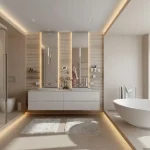The Importance of Plumbing Design
3 min read
Plumbing systems deliver water into buildings and remove waste water out. A plumbing system also includes process piping that transports gases, chemicals and fluids between locations.
Plumbing designers use various official symbols to depict a system on paper. They also produce plan and riser drawings to estimate approximate lengths of supply pipes.
Drainage
Drainage refers to the system of pipes used to transport waste water away from fixtures, sinks and showers and into sewer systems or septic tanks for disposal. Drainage systems utilize gravity in order to transport this water efficiently.
Plumbing engineers use various sizing and design techniques to ensure each drainage pipe is appropriately sized for its volume of traffic, to reduce blockages and overflows.
Drainage pipe sizes depend on how many fixtures they will serve and their usage patterns. Plumbing industry uses various pipes such as GI, PVC, ABS and uPVC in various sizes for drainage applications.
Foul drainage transports wastewater from baths, basins, kitchen sinks and washing machines through pipes into sewer systems – commonly referred to as grey or black water. Each fixture must have an individual “P” trap installed within 3 feet for proper functioning of foul drainage system and roof vents installed to prevent backflow of sewage into home.
Supply
Plumbing supply refers to the process of providing freshwater to buildings. It also encompasses waste water collection systems. An efficiently designed plumbing supply can save energy, prevent leaks and lower backflow risk. Furthermore, it should be accessible for people with disabilities – this means sizing appropriate pipes and placing fixtures within reach of wheelchairs.
Piping layout refers to the geometrical arrangement of all of the pipes used to deliver water to plumbing fixtures. It is determined by both governing plumbing codes and by how many water supply fixture units (WSFUs) each pipe size can serve, which allows us to estimate probable demand and design a suitable piping system.
Plumber stores the values you select in the configuration tab in its options and calculation unit tables, automatically restoring them when creating new projects.
Main Stack
A plumbing stack serves as the central hub from which all your home’s plumbing fixtures branch off, directing waste water and sewage into your sewer line while venting any toxic gases that accumulate in pipes.
Recognizing signs that your plumbing stack requires repair or replacement is crucial. Slow drainage in kitchen sinks or toilets could indicate sediment build-up in your plumbing stack.
Clogging is often the number one problem for plumbing stacks, typically caused by improperly sized branch drains that allow debris to pass through more easily than intended. Other issues can include leaky faucets allowing water leakage through and lack of regular maintenance of pipes resulting in rust spots forming on them. To address these issues effectively, the 2024 UPC features a new single-stack configuration which requires an auxiliary vent pipe for water closets and tubs as well as restricting vertical extension distances to protect against self-siphonage.
Corners
When plumbing passes through corners, it’s essential that they be designed at gradual angles rather than right angles to avoid clogs and give more flexibility for bends and slopes. A gridded straightedge can make drawing your plan simpler to read while preformed Oatey dam corners come preformed for shower installations that work with either PVC or CPE liners; right or left hand versions are also available with various fittings.
















